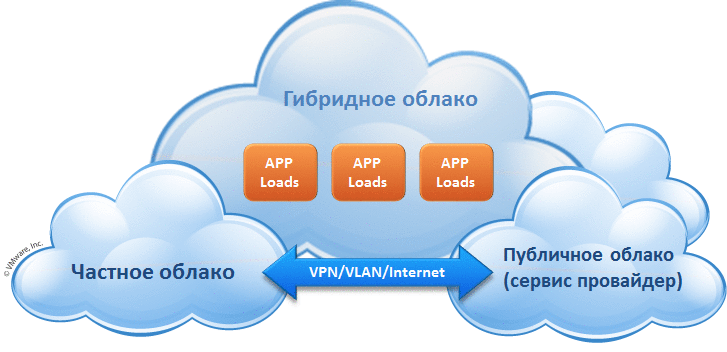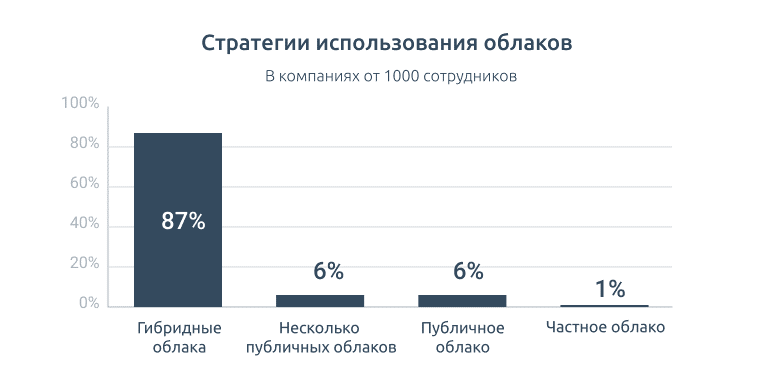Hybrid clouds have just started gaining popularity in Russia. Russian providers now provide high-quality public clouds, and more and more customers have started to consider it as an additional backup platform or a place where they can move some applications. In this article, we will tell you more about how to build a hybrid cloud, what are its features, and what are the subtleties of moving to a hybrid cloud infrastructure.
- Hybrid cloud infrastructure
- Benefits of hybrid clouds
- Hybrid cloud infrastructure use cases
- Subtleties of moving to a hybrid cloud
- The concept of hybrid infrastructure implementation by Softline
- Example of successful implementation of a hybrid system by Softline
Research by Nutanix, an American hardware and software developer, shows that the hybrid cloud will become the most promising IT delivery model over the next five years. It is obvious that many companies don't want to be limited to a private or public cloud but want to get as many benefits as possible from a combination of the two.
What are the components of a hybrid cloud infrastructure?
A hybrid cloud consists of one or more private clouds. They are usually hosted by a customer or a partner data center, but in both cases, they serve only one customer, and one or more public clouds, which can be located either on- or offsite. A hybrid cloud always needs a cloud resource management platform. It greatly enhances the hybrid cloud usability and allows the customer to work with all connected clouds, both private and public, from a unified control panel. Without such a platform, the customer has to manage each private and public cloud separately, which significantly increases the administration costs. The best platforms can even analyze the available cloud usage models and recommend to customers how to improve cloud efficiency by 30-50%.

Hybrid cloud diagram
Benefits of hybrid clouds
If the demand for computing and data processing begins to exceed the resource capacity of the local data center, companies can use the cloud to quickly ramp up its computing power. A hybrid cloud infrastructure that features several public cloud environments from multiple cloud providers allows you to combine best-in-class cloud services from different cloud providers.

In addition, hybrid clouds allow customers to:
- Start the cloud journey. Companies that are new to the cloud find it convenient to start by hosting business-critical services in their own private cloud and to move the rest of the services to the public cloud.
- Consciously choose a hybrid cloud, distributing workloads between private and public clouds based on cost and required SLA. For example, services that require maximum network connection speed should be preferably hosted in a private cloud at the customer's site, and long-term data backups can be deployed to a public cloud, which has lower storage costs.
- Use the public cloud as a backup if there is a shortage of private cloud resources. For example, at peak times, resources in the public cloud can be added to resources in the local cloud.
- Combine the benefits of the public cloud with the customization potential of the private cloud infrastructure to meet the customer's needs.
- Comply with regulatory requirements for personal daQta storage and cross-border data transfer. A private cloud can be certified under Federal Law of Russia No. FZ-152 "On Personal Data" to store data protected by this law. At the same time, other workloads can be moved to public clouds.
A table comparing private, public, and hybrid clouds
| Private clouds | Public clouds | Hybrid clouds | |
|---|---|---|---|
| Entry threshold | High: You need to design the system, purchase equipment, engage qualified experts | Low: Just pay for the services and use the computing power | High: You need not only to deploy a private cloud but also to configure its integration with the public cloud. |
| Operation cost | High: All costs are borne by the owner. You have to update your equipment and licenses. | Low: The costs are borne by the provider. | Medium: A part of the cost of maintaining the infrastructure falls on the provider. |
| Maintenance complexity | High: You need to monitor the infrastructure personally and fix problems. | Low: The provider undertakes the monitoring of the software platform and hardware health. | High: You need to maintain the private part of the cloud personally and interact with providers. |
| Scaling speed | Low: You need to purchase and configure hardware | High: Additional power available instantly on demand | High: you can quickly ramp up capacity by extending your workloads to the public cloud sector |
| Information security |
High with proper design: All infrastructure is controlled by the owner |
Low: You can't control many important issues, because they lie in the provider's hands. | High with the right design: important services can be moved to the private sector of the cloud where they are fully controlled |
Hybrid cloud use cases
Hybrid clouds are the most popular among those companies that have to comply with the requirements of Russian law in terms of storing and transferring information. In this case, data subject to storage and transfer restrictions is stored in the customer's private cloud, and other data are transferred to public clouds. Companies also often move test environments, sandboxes for software testing, and rarely used data, such as backups, to public clouds because the data storage cost in the public cloud is much lower than in the private cloud. Thus, hybrid clouds are suitable for all SMBs and bigger companies, who lack the functionality of only public clouds for a number of reasons. Other common use cases for hybrid clouds include:
- Constantly changing workloads. Using an easily scalable public cloud is optimal for dynamic workloads, and power-consuming or more sensitive workloads can be migrated to a private cloud or a corporate data center.
- Big Data processing. It is unlikely that demand for big data processing always remains stable. Therefore it is a better option to use big data analytics with highly scalable public cloud resources and a private cloud to secure and protect sensitive big data by a firewall.
- Gradual migration to the cloud. With a hybrid cloud, you can place some workloads in a public cloud or a small private cloud and understand what's right for your company. You can expand your presence in the cloud, if necessary—in public and private clouds or by combining these two components.
- Temporary computing capacity. Hybrid cloud allows you to allocate public cloud resources for short-term projects at a lower cost than using your in-house data center IT infrastructure. This way, you are not investing in equipment that is only needed for short time.
Subtleties of moving to a hybrid cloud
It is best to start the transition to a hybrid cloud with the development of a roadmap, since using a combination of private and public clouds, despite the obvious advantages, is rather difficult to plan. Therefore, to develop a roadmap, it is best to invite professional consultants experienced in the development of this kind of documents. The following subtleties need to be taken into account:
- Analysis of current cloud resource consumption scenarios, if any clouds are already in use, or if the customer plans to use clouds.
- Planning network connectivity between clouds to meet required SLAs and ensure information security when transferring data from one cloud to another.
- Compliance with legal requirements for data storage and transfer. For example, cross-border data transfer, storage of personal data on the territory of Russia, and so on.
- The need for rapid scaling in the event of a load surge, which is typical, for example, for online stores during periods of increased demand, during sales, and before holidays.
- Required SLA at the customer application level. For example, you can run virtual machines from the customer's private cloud, and consume PaaS (Platform as a Service) resources such as DBaaS (database as a service) from the public cloud, since such a database will have higher availability than that of a private cloud hosted inside a VM.
How does Softline implement the hybrid cloud concept?
Once the roadmap has been developed and approved, Softline engineers make a customer infrastructure audit to assess the readiness of the private cloud to operate in a hybrid environment. At this point, consultants should give way to cloud architects and engineers. Here the advantage of Softline is that it has excellent competencies in all areas necessary for high-quality planning and migration implementation—consultants, information security, IT infrastructure, and cloud technology experts. Softline helps the customer make the step into the hybrid cloud by starting a joint project with the customer and developing a statement of work, test program and methodology, and other project documentation.
The hybrid cloud journey should be as seamless as possible for the customer, but it is necessary to coordinate all the interactions between Softline and customer specialists. This task is solved by a qualified project manager appointed by Softline and controlling the implementation of the customer's statement of work and roadmap. In some cases, if the customer's private cloud is not located at the customer site, the project manager also interacts with contractors, such as providers of dedicated Internet channels and data centers. This is the only way to make the hybrid cloud transition smooth and seamless for the customer.
According to the roadmap, the workloads are transferred to the hybrid cloud only after the technical part of creating a hybrid cloud has been completed, load tests have been carried out, and an acceptance certificate has been signed, and the customer has been trained to use the CloudMaster hybrid cloud management platform, the customer, in accordance with the roadmap. And then, depending on the interaction format preferred by the customer, Softline is responsible either for all the components of the hybrid cloud, including the private cloud, or for the public segment of the hybrid cloud, or for their combination. Usually, the customer operates their private cloud, and Softline is responsible for the public segment and for the inter-site network connectivity. The main users of Softline's hybrid clouds are financial companies and software vendors. Both benefit a lot from bringing test environment workloads to the public cloud.
Vodokanal case study: IT infrastructure modernization powered by Softline cloud services
Softline has been closely cooperating with Rosvodokanal for more than 5 years in matters related to cloud services. The company promptly developed an IaaS solution for the customer based on a proprietary public cloud and dedicated servers. Softline cloud is powered by a certified FlexPod platform, which is based on NetApp storage systems, Cisco servers and switches, and VMware software. This cloud service offers such benefits as reduced IT infrastructure, flexible scalability, and easy virtual data center management via the vCloud Director web interface. Planning to use the full potential of the Softline public cloud in the future, Rosvodokanal Group has already transferred a part of its own IT infrastructure to it.
The customer needed dedicated capacities for the successful operation of services such as 1C and billing systems. Softline offered a dedicated service powered by modern Dell EMC PowerEdge rack-mounted servers. This solution supports connecting a large number of cloud services. For example, the 1C server is connected to a STaaS service for rapid memory scaling. With this service, Rosvodokanal Group can avoid purchasing new hardware, transfer capital costs to operating costs, and thus invest more in the development of corporate business. An obvious advantage of the dedicated cloud model is that the IT infrastructure can be scaled both up and down.
The customer also requested Softline to perform a comprehensive IT infrastructure audit. The group's server rooms have been located in different cities of Russia and did not support the same standard. As a result of the study, the provider's experts developed a three-year infrastructure modernization strategy and suggested moving all Rosvodokanal services to the cloud.
"Thanks to our IaaS solution, the customer has already migrated part of in-house IT infrastructure to the Softline public cloud. Dedicated servers will help them to stabilize the operation of critical services. The project will be further improved. We plan to upgrade the IT infrastructure of all customer's regional offices by moving local services to the cloud and allocating a separate infrastructure segment connected to a Disaster Recovery-as-a-Service solution. In addition, together with Rosvodokanal Group IT experts, we are exploring the possibility of 1C database scaling and using a new storage system. Another promising project is providing the Disaster Recovery service, which is necessary to restore the IT infrastructure operation and retain data in the event of failures or accidents," outlined the prospects of cooperation with Rosvodokanal Group Vadim Bukovsky, Head of Sales Department of Softline Cloud Technologies Department.
Watch our video about the secrets of building a hybrid infrastructure:
<iframe allow="accelerometer; autoplay; clipboard-write; encrypted-media; gyroscope; picture-in-picture" allowfullscreen=" frameborder=" 0"="" height="315px" scrolling="no" src="https://www.youtube.com/embed/nC7lDZDwQ2Q" title="YouTube video player" width="560px">










